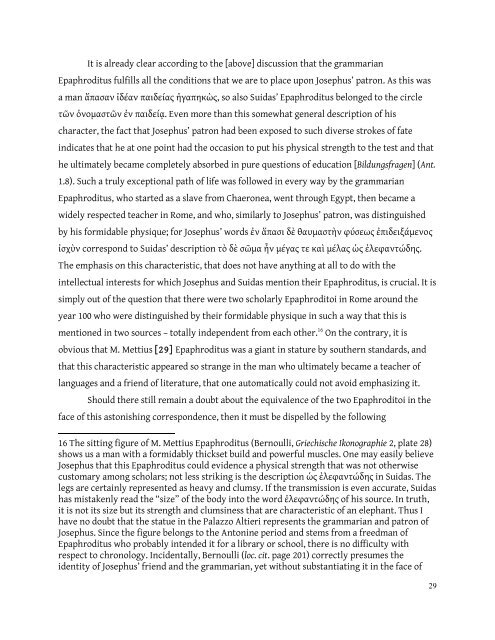The Jewish Historian Flavius Josephus: A Biographical Investigation
The Jewish Historian Flavius Josephus: A Biographical Investigation
The Jewish Historian Flavius Josephus: A Biographical Investigation
Create successful ePaper yourself
Turn your PDF publications into a flip-book with our unique Google optimized e-Paper software.
It is already clear according to the [above] discussion that the grammarian<br />
Epaphroditus fulfills all the conditions that we are to place upon <strong>Josephus</strong>’ patron. As this was<br />
a man ἅπασαν ἰδέαν παιδείας ἠγαπηκὼς, so also Suidas’ Epaphroditus belonged to the circle<br />
τῶν ὀνομαστῶν ἐν παιδείᾳ. Even more than this somewhat general description of his<br />
character, the fact that <strong>Josephus</strong>’ patron had been exposed to such diverse strokes of fate<br />
indicates that he at one point had the occasion to put his physical strength to the test and that<br />
he ultimately became completely absorbed in pure questions of education [Bildungsfragen] (Ant.<br />
1.8). Such a truly exceptional path of life was followed in every way by the grammarian<br />
Epaphroditus, who started as a slave from Chaeronea, went through Egypt, then became a<br />
widely respected teacher in Rome, and who, similarly to <strong>Josephus</strong>’ patron, was distinguished<br />
by his formidable physique; for <strong>Josephus</strong>’ words ἐν ἅπασι δὲ θαυμαστὴν φύσεως ἐπιδειξάμενος<br />
ἰσχὺν correspond to Suidas’ description τὸ δὲ σῶμα ἦν μέγας τε καὶ μέλας ὡς ἐλεφαντώδης.<br />
<strong>The</strong> emphasis on this characteristic, that does not have anything at all to do with the<br />
intellectual interests for which <strong>Josephus</strong> and Suidas mention their Epaphroditus, is crucial. It is<br />
simply out of the question that there were two scholarly Epaphroditoi in Rome around the<br />
year 100 who were distinguished by their formidable physique in such a way that this is<br />
mentioned in two sources – totally independent from each other. 16 On the contrary, it is<br />
obvious that M. Mettius [29] Epaphroditus was a giant in stature by southern standards, and<br />
that this characteristic appeared so strange in the man who ultimately became a teacher of<br />
languages and a friend of literature, that one automatically could not avoid emphasizing it.<br />
Should there still remain a doubt about the equivalence of the two Epaphroditoi in the<br />
face of this astonishing correspondence, then it must be dispelled by the following<br />
16 <strong>The</strong> sitting figure of M. Mettius Epaphroditus (Bernoulli, Griechische Ikonographie 2, plate 28)<br />
shows us a man with a formidably thickset build and powerful muscles. One may easily believe<br />
<strong>Josephus</strong> that this Epaphroditus could evidence a physical strength that was not otherwise<br />
customary among scholars; not less striking is the description ὡς ἐλεφαντώδης in Suidas. <strong>The</strong><br />
legs are certainly represented as heavy and clumsy. If the transmission is even accurate, Suidas<br />
has mistakenly read the “size” of the body into the word ἐλεφαντώδης of his source. In truth,<br />
it is not its size but its strength and clumsiness that are characteristic of an elephant. Thus I<br />
have no doubt that the statue in the Palazzo Altieri represents the grammarian and patron of<br />
<strong>Josephus</strong>. Since the figure belongs to the Antonine period and stems from a freedman of<br />
Epaphroditus who probably intended it for a library or school, there is no difficulty with<br />
respect to chronology. Incidentally, Bernoulli (loc. cit. page 201) correctly presumes the<br />
identity of <strong>Josephus</strong>’ friend and the grammarian, yet without substantiating it in the face of<br />
29
















